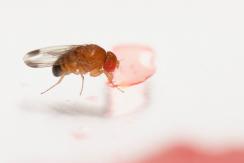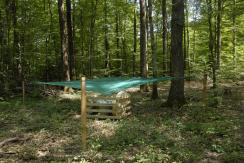Evolutionary Ecology
The department of Evolutionary Ecology gathers complementary skills in behavioural ecology, population dynamics, population biology, community ecology, and methodology (statistics and modelling). The research done in the department aims at studying how animal species evolve in a changing world by understanding the causes of the evolution of traits, adaptations and interactions. For that, we consider different levels of organization from individuals to populations and communities. Because organisms cannot be considered isolated from other biotic factors, we consider pathogens but also competing species within communities.
We study how individuals adapt to their environments that are largely impacted by anthropic pressures, and how life history traits and behaviour evolve in response to these pressures. Although we mainly focus on phenotype, we more and more consider the mechanistic link between the genotype and the phenotype. We develop the theoretical framework of our discipline through a conceptual and modeling approach. In parallel, we test hypotheses that arise from theoretical predictions through experimental, comparative and observational approaches on different biological models (insects, birds, mammals). Experimental approaches are developed in the laboratory (insect model) and in natura (bird, insect and mammal models). Observational and comparative research is mainly concerned with vertebrates. Our approaches are also, and increasingly, interested in the mechanisms of adaptive responses. In addition to the classical approaches of demographic analysis and trait change, methods of ecophysiology, chemical ecology and molecular biology are used.
Our department hosts several long-term studies of wild populations of different species. These long-term studies offer a valuable way to understand how biotic and abiotic factors affect individuals’ life history traits, and the functioning of populations in natura. Five populations of mammalian species are thus monitored for several years (more than 40 years on roe deer, 30 on Alpine marmots, 25 years on cats, 16 years on zebras, and 20 years on impala). Two of our study sites (La Sassière in Vanoise National Park (Alpine marmots) and Hwange National Park) have been certified as “Site d’Etude en Ecologie Globale” (SEEG), and two (ZA “Hwange” and ZA “Antarctic and sub-Antarctic”) were certified as “Zone Atelier” by the CNRS.
The department of Evolutionary ecology is also largely involved in training activities. Lastly, we also have strong socio-economic relationships. Indeed, because we address questions of major societal interest (global warming, public health) we tightly collaborate with socio-economic partners (Office Français de la Biodiversité, Vanoise National Park, Hwange National Park in Zimbabwe, Office National des Forêts, etc.) and participate to general public and media events.
Publications
Display of 811 to 840 publications on 2459 in total
Old females rarely mate with old males in roe deer, Capreolus capreolus
Biological Journal of the Linnean Society . 128 ( 3 ) : 515-525
Journal article
see the publicationPattern of latrine use by domestic cats on dairy farms and the implications for Toxoplasma gondii transmission
Veterinary Parasitology . 273 : 112-121
Journal article
see the publicationSilver spoon effects are constrained under extreme adult environmental conditions
Ecology .
DOI: 10.1002/ecy.2886
Journal article
see the publicationA local evaluation of the individual state-space to scale up Bayesian spatial capture-recapture
Ecology and Evolution . 9 ( 1 ) : 352-363
DOI: 10.1002/ece3.4751
Journal article
see the publicationThe two oxpecker species reveal the role of movement rates and foraging intensity in species coexistence
Biology Letters . 15 ( 10 ) : 20190548
Journal article
see the publicationAntioxidant capacity is repeatable across years but does not consistently correlate with a marker of peroxidation in a free-living passerine bird
Journal of Comparative Physiology B . 189 ( 2 ) : 283-298
Journal article
see the publicationGenetic structure of a European forest species, the edible dormouse (Glis glis): A consequence of past anthropogenic forest fragmentation?
Biological Journal of the Linnean Society . 126 ( 4 ) : 836-851
Journal article
see the publicationThe neutrophil to lymphocyte ratio indexes individual variation in the behavioural stress response of wild roe deer across fluctuating environmental conditions
Behavioral Ecology and Sociobiology . 73 ( 11 ) : 1-13
Journal article
see the publicationModelling of omics dose-response data for ecological risk assessment
Journées du GDR Ecologie Statistique (EcoStat) .
Conference paper
see the publicationNew goodness-of-fit plots for censored data in the package fitdistrplus
7ème rencontres R .
Conference paper
see the publicationHétérogénéité de transmission de la brucellose chez le Bouquetin des Alpes
Rencontre des doctorants de l’école doctorale Évolution, Écosystème, Microbiologie, Modélisation .
Poster
see the publicationBoundary constraints on population dynamics in a percolating habitat
Ecological Complexity . 36 : 230-238
Journal article
see the publicationOverview of GeoLifeCLEF 2018: location-based species recommendation
CLEF 2018 - Conference and Labs of the Evaluation Forum . 2125 ( 8 )
Conference paper
see the publicationTwo dimensions define the variation of fine root traits across plant communities under the joint influence of ecological succession and annual mowing
Journal of Ecology . 106 ( 5 ) : 2031 - 2042
Journal article
see the publicationA deep learning approach to Species Distribution Modelling
Multimedia Tools and Applications for Environmental & Biodiversity Informatics . 978-3-319-76444-3 : 169-199
Book chapter
see the publicationWhat makes trait-abundance relationships when both environmental filtering and stochastic neutral dynamics are at play?
Oikos . 127 ( 12 ) : 1735-1745
DOI: 10.1111/oik.05398
Journal article
see the publicationEcological and biogeographical drivers of freshwater green algae biodiversity: from local communities to large-scale species pools of desmids
Oecologia . 186 ( 4 ) : 1017-1030
Journal article
see the publicationecolottery : Simulating and assessing community assembly with environmental filtering and neutral dynamics in R
Methods in Ecology and Evolution . 9 ( 3 ) : 693-703
Journal article
see the publicationFunctional rarity of coral reef fishes at the global scale: Hotspots and challenges for conservation
Biological Conservation . 226 : 288-299
Journal article
see the publicationHétérogénéités d’infestations parasitaires : origines et conséquences détectables lors d’infestations naturelles
Pollen limitation as a main driver of fruiting dynamics in oak populations
Ecology Letters . 22 ( 1 ) : 98-107
DOI: 10.1111/ele.13171
Journal article
see the publicationA Bayesian approach to estimate biodynamic model parameters: bioaccumulation of PCB 153 by the freshwater crustacean Gammarus fossarum
SETAC . : 1
Poster
see the publicationApproche bayésienne pour estimer les paramètres d'un modèle biodynamique chez les invertébrés benthiques d'eau douce
SEFA . : 20
Conference paper
see the publicationClimate change and functional traits affect population dynamics of a long-lived seabird
Journal of Animal Ecology . 87 ( 4 ) : 906 - 920
Journal article
see the publicationFrom early-life to senescence: individual heterogeneity in a long-lived seabird
Ecological monographs . 88 ( 1 ) : 60-73
DOI: 10.1002/ecm.1275
Journal article
see the publicationFirst demographic insights on historically harvested and poorly known male sperm whale populations off the Crozet and Kerguelen Islands (Southern Ocean)
Marine Mammal Science . 34 ( 3 ) : 595-615
DOI: 10.1111/mms.12469
Journal article
see the publicationL’apport de de la modélisation dans la compréhension du système brucellose – bouquetin du Bargy
Journée AEEMA. Maisons-Alfort .
Conference paper
see the publicationL’apport de de la modélisation dans la compréhension du système brucellose – bouquetin du Bargy
Epidémiologie et Santé Animale . ( 74 ) : 43-54
Journal article
see the publicationHow to implement functional responses of migroalgae in risk assessment processing ?
Congrès européen de la SETAC «Science and Technology for Environmental Protection» .
Conference paper
see the publicationHistoire de l’extinction du pestivirus chez les isards de la réserve d’Orlu
36èmes rencontres du GEEFSM .
Conference paper
see the publication





You also, comment on this article